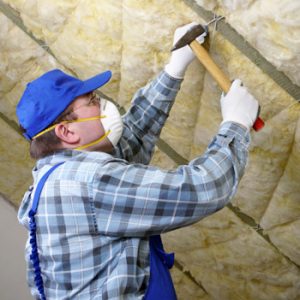Energy Efficiency Jobs
Floor, ceiling and wall insulation workers are critical to helping create and maintain an energy efficient home and office.
Floor, ceiling and wall insulation workers are critical to helping create and maintain an energy efficient home and office.
Floor, ceiling and wall insulation workers install and replace the materials used to insulate homes and office buildings making them more energy efficient. These green job holders are often referred to as insulators. As part of their job, floor, ceiling and wall insulation workers read blueprints and specifications to determine the appropriate insulation materials required and the amount needed to properly insulate homes and buildings.
Before starting the insulation application, insulators prepare the insulation surfaces by brushing or spreading on adhesives, cement, asphalt, or by attaching metal pins to surfaces. They then use hand tools such as tape measures, handsaws, power saws, knives, or scissors to measure and cut insulation materials to fit into walls or surfaces. Floor, ceiling and wall insulation workers use additional tools such as blowers to cover and line structures with insulating material to protect structures against heat, cold or moisture. To finish up the job, they cover and seal insulated surfaces with plastic covers, canvas strips, sealants, tape, cement or asphalt mastic to protect insulation from moisture.
 Floor, ceiling and wall insulation workers are required to follow safety guidelines. When remodeling old buildings, they often must remove old insulation. In some old industrial buildings, asbestos – a material linked to cancer was used to insulate walls and ceilings. Because of this, it’s required to be removed by licensed insulators before new insulation materials can be installed.
Floor, ceiling and wall insulation workers are required to follow safety guidelines. When remodeling old buildings, they often must remove old insulation. In some old industrial buildings, asbestos – a material linked to cancer was used to insulate walls and ceilings. Because of this, it’s required to be removed by licensed insulators before new insulation materials can be installed.
Floor, ceiling and wall insulation workers usually work indoors in residential and industrial settings. During the workday they are often required to stand, bend, or kneel in confined spaces. Floor, ceiling, and wall insulators have a higher rate of injury than others professions. To protect themselves from small particles, they keep the work area well ventilated. They also wear protective suits, masks, and may wear respirators. Most floor, ceiling, and wall insulators were employed in the drywall and insulation contractors industry and have a 40-hour work week. Only 4% of insulators are self-employed.
A floor, ceiling and wall insulation worker usually enters this green career with some previous work-related skill, knowledge, or experience. There are no formal education requirements for floor, ceiling, and wall insulation workers. High school courses in English, math, woodworking, mechanical drawing, algebra, and general science are considered helpful for this job. Employees in these jobs are required to obtain up to one year of on-the-job training with more experienced workers. There are 2 recognized apprentice-able specialties associated with this job: Cork Insulator and Refrigeration Plant; Insulation Worker. Insulation workers who work with asbestos must be certified by the U.S. Environmental Protection Agency (EPA). Voluntary certification may be provided by some insulation contractor organizations to help workers demonstrate their skills and knowledge of residential and industrial insulation.
The Bureau of Labor Statistics (BLS) expects employment of this field to grow 23 percent from 2010 until 2020; this is faster than the average for all green jobs. The increasing demand in improving energy efficiency for homes and buildings will result in good employment opportunities for insulators although they will face competition for jobs. The BLS projected 14,600 floor, ceiling and wall insulation workers job openings between 2010 and 2020, and noted 23,000 jobs are currently filled. Titles included insulation installer, insulator, insulation estimator, retrofit installer, insulation mechanic, and warehouse insulation worker. The BLS further reports that the median annual wage for salaried floor, ceiling and wall insulation workers was $32,420 in 2011 with median hourly wage of $15.59. The lowest 10 percent earned less than $20,360, and the top 10 percent earned more than $60,990.